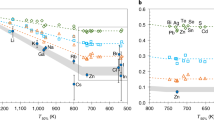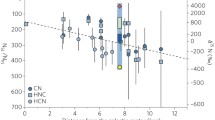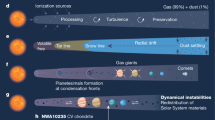Abstract
The solar system is apparently stratified with regard to the contents of volatile constituents, as judged from the rocky, volatile-poor inner solar system planets and meteorites and the huge volatile-rich outer planets. However, beyond this gross structure there is no evidence for a systematic increase of the volatiles' abundances with distance from the Sun. Although meteorites show comparatively large differences in volatile element contents they also differ in many other respects, such as Mg/Si-ratios, bulk Fe and refractory element contents. These variations reflect variations in the nebular environment from which meteorites formed. The various conditions of meteorite formation cannot, however, be related in a simple way to heliocentric distances.
There are also no systematic variations in the chemistry of the inner planets Mercury, Venus, Earth, Moon, Mars, and including the fourth largest asteroid Vesta, that could be interpreted as a relationship between volatility and composition. Although Mars (as judged from the composition of Martian meteorites) is more oxidized and contains more volatile elements than Earth, this trend cannot be extrapolated to the dry volatile poor Vesta (sampled by HED meteorites) in the asteroid belt. If the Earth-Mars trend reflects global inner solar system gradients then Vesta must have formed inside Earth's orbit and moved out later to its present location. The quality of Mercury and Venus composition data is not sufficient to allow reliable extrapolation to distances closer to the Sun.
Recent nebula models predict small temperature gradients in the inner solar system supporting the view that no large variations in volatile element contents of inner solar system materials are expected.
Similar content being viewed by others
References
Bell, J. F., Davies, D.R., Hartmann, W.K., and Gaffey, M. J.: 1989, 'Asteroids: The Big Picture', in R. P. Binzel, T. Gehrels, and M. S. Matthews (eds.), Asteroids II, Univ. of Arizona Press, Tucson, pp. 921–945.
Bischoff, A., Palme, H., Ash, R. D., Clayton, R. N., Schultz, L., Herpers, U., Stöffler, D., Grady, M. M., Pillinger, C. T., Spettel, B., Weber, H., Grund, T., Endreá, M., and Weber, D.: 1993a, 'Paired Renazzo-type (CR) Carbonaceous Chondrites From the Sahara', Geochim. Cosmochim. Acta 57, 1587–1603.
Bischoff, A., Palme, H., Schultz, L., Weber, D., Weber, H.W., and Spettel, B.: 1993b, 'Acfer 182 and Paired Samples, an Iron-rich Carbonaceous Chondrite: Similarities With ALH85085 and its Relationship to CR chondrites', Geochim. Cosmochim. Acta 57, 2631–2648.
Cameron, A.G.W., Fegley, B., Jr., Benz, W., and Slattery, W. L.: 1988, 'The Strange Density of Mercury: Theoretical Considerations', in M. S. Matthews, C. Chapman and F. Vilas (eds.), Mercury, Univ. of Arizona Press, Tucson, pp. 692–798.
Cassen, P.: 1994, 'Utilitarian Models of the Solar Nebula', Icarus 112, 405–429.
Cassen, P.: 1996, 'Models for the Fractionation ofModerately Volatile Elements in the Solar Nebula', Meteoritics and Planet. Sci. 31, 793–806.
Clayton, R.N.: 1993, 'Oxygen Isotopes in Meteorites', Ann. Rev. Earth Planet. Sci. 21, 115–149.
Dreibus, G., and Wänke, H.: 1980, 'The Bulk Composition of the Eucrite Parent Asteroid and its Bearing on Planetary Evolution', Z. Naturforsch. 35a, 204–216.
Dreibus, G., and Wänke, H.: 1990, 'Comparison of the Chemistry of Moon and Mars', Adv. Space. Res. 10, (3)7–(3)16.
Floss, C., El Goresy, A., Zinner, E., Kransel, G., Rammensee, W., and Palme, H.: 1996, 'Elemental and Isotopic Fractionation Produced Through Evaporation of the Allende CV Chondrite: Implications for the Origin of HAL-type Hibonite Inclusions', Geochim. Cosmochim. Acta 60, 1975–1997.
Flynn, G. J., Bajt, S., Sutton, S., Zolesky, M. E., Thomas, K. L., and Keller, L. P.: 1996, 'The Abundance Pattern of Elements Having Low Nebular Condensation Temperatures in InterplanetaryDust Particles: Evidence for a New Chemical Type of Chondritic Material', in A. S. Gustafson and M. S. Hanner (eds.), Physics, Chemistry, and Dynamics of Interplanetary Dust, ASP Conf. Ser. 104, pp. 291–204.
Humayun, M., and Clayton, R.N.: 1995, 'Potassium Isotope Cosmochemistry, Genetic Implications of Volatile Element Depletion', Geochim. Cosmochim. Acta 59, 2115–2130.
Jessberger, E. K., Christoforidis, A., and Kissel, J.: 1988, 'Aspect of the Major Element Composition of Halley's Dust', Nature 332, 691–695.
Jochum, K. P., and Palme, H.: 1990, 'Alkali Elements in Eucrites and SNC-Meteorites: No Evidence for Volatility Related Losses During Magma Eruption or Thermal Metamorphism', Meteoritics 25, 373.
Kargel, J. S., and Lewis, J. S.: 1993, 'The Composition and Early Evolution of the Earth'. Icarus 105, 1–25.
Kato, T., Ringwood, A. E., and Irifune, T.: 1988, 'Experimental Determination of Element Partitioning Between Silicate Perovskites, Garnets and Liquids: Constraints on Early Differentiation of the Mantle', Earth Planet. Sci. Lett. 89, 123–145.
Larimer, J.W.: 1979, 'The Condensation and Fractionation of Refractory Lithophile Elements', Icarus 40, 446–454.
Larimer, J.W., and Bartholomay, M.: 1979, 'The Role of Carbon and Oxygen in Cosmic Gases: Some Applications to the Chemistry and Mineralogy of Enstatite Chondrites', Geochim. Cosmochim. Acta 43, 1453–1466.
Lewis, J.: 1974, 'The Temperature Gradients in the Solar Nebula', Science 186, 440–442.
Lipschutz, M. E., and Woolum, D. S.: 1988, 'Highly Labile Elements', in J. F. Kerridge and M. S. Matthews (eds.), Meteorites and the Early Solar System. Univ. Arizona Press, Tucson, pp. 462– 487.
Lodders, K.: 2000, 'An Oxygen Isotope Mixing Model for the Accretion and Composition of Rocky Planets', Space Sci. Rev., this volume.
Lodders, K., and Fegley, B.F., Jr.: 1998, 'The Planetary Scienticst's Companion', Oxford Univ. Press, Oxford.
Lugmair, G.W., and Shukolyukov, A.: 1998, 'Early Solar System Timescales According to 54Mn– 53Cr Systematics', Geochim. Cosmochim. Acta 62, 2863–2886.
McDonough, W. F., and Sun, S.-s.: 1995, 'The Composition of the Earth', Chemical Geology 120, 223–253.
Mittlefehldt, D.W.: 1987, 'Volatile Degassing of Basaltic Achondrite Parent Bodies: Evidence From Alkali Elements and Phosphorus', Geochim. Cosmochim. Acta 51, 267–278.
O'Neill, H.St.C., and Palme, H.: 1998, 'Composition of the Silicate Earth: Implications for Accretion and Core Formation', in I. Jackson (ed.), The Earth's Mantle: Structure, Composition and Evolution – the Ringwood Volume, Cambridge Univ. Press, pp. 3–126.
Palme, H.: 1990, 'Back to the Earth's Beginnings', Nature 343, 23–24.
Palme, H., and Rammensee, W.: 1981, 'The Significance ofWin Planetary Differentiation Processes: Evidence From new Data on Eucrites', Proc. 12th Lunar Planet. Sci. Conf., pp. 949–964.
Palme, H., and Nickel, K.: 1985, 'Ca/Al Ratio and Composition of the Earth's Upper Mantle', Geochim. Cosmochim. Acta 49, 2123–2132.
Palme, H., and Beer, H.: 1993, 'Abundances of the Elements in the Solar System', in H. H. Voigt (ed.), Landolt–Börnstein, Group VI: Astronomy and Astrophysics 3(a) (Instruments; Methods; Solar System), Springer, Berlin, pp. 196–221.
Palme, H., and Boynton, W.V.: 1993, 'Meteoritic Constraints on Conditions in the Solar Nebula', in E.H. Levy and J. I. Lunine (eds.), Protostars and Planets III, Univ. of Arizona Press, Tucson, pp. 979–1004.
Palme, H., Larimer, J.W., and Lipschutz, M. E.: 1988, 'Moderately Volatile Elements', in J. F. Kerridge and M. S. Matthews (eds.), Meteorites and the Early Solar System, Univ. Arizona Press, Tucson, pp. 436–461.
Pepin, R. O.: 1989, 'Atmospheric Compositions: Key Similarities and Differences', in S. Atreya, J.B. Pollack, and M. S. Matthews (eds.), Origin and Evolution of Planetary Satellite Atmospheres, Univ. Arizona Press, Tucson, pp. 294–305.
Pollack, J.B.: 1984, 'Origin and History of the Outer Planets: Theoretical Models and Observational Constraints', Ann. Rev. Astrophys. 22, 389–424.
Ringwood, A. E.: 1979, 'Origin of the Earth and Moon', Springer, New York. 295 pp.
Ringwood, A. E.: 1989, 'Significance of the Terrestrial Mg/Si Ratio', Earth and Planet. Sci. Lett. 95, 1–7.
Shukolyukov, A., and Lugmair, G.W.: 1998, 'Isotopic Evidence for the Cretaceous-Tertiary Impactor and its Type', Science 282, 927–929.
Schulze, H., Bischoff A., Palme, H., Spettel, B., Dreibus, G. and Otto, J.: 1994, 'Mineralogy and Chemistry of Rumuruti: The First Meteorite Fall of the new R-Chondrite Group', Meteoritics 29, 275–286.
Takahashi, H., Gros, J., Highuchi, H., Morgan, J.W., and Anders, E.: 1978, 'Volatile Elements in Chondrites: Metamorphism or Nebular Fractionation?', Geochim. Cosmochim. Acta 42, 1859–1869.
Taylor, S.R.: 1992, 'Solar System Evolution', Cambridge Univ. Press, Cambridge.
Wasson, J. T.: 1985, 'Meteorites: Their Record of Early Solar-System History', W.H. Freeman and Company, New York.
Wasson, J. T., and Wetherill, G.W.: 1979, 'Dynamical, Chemical and Isotopic Evidence Regarding the Formation of Locations of Asteroids and Meteorites', in T. Gehrels, Asteroids, Univ. Arizona Press, Tucson, pp. 926–974.
Wasson, J. T., and Kallemeyn, G.W.: 1988, 'Composition of Chondrites', Phil. Trans. R. Soc. Lond. A 325, 535–544.
Weidenschilling, S. J.: 2000, 'Formation of Planetesimals and Accretion of the Terrestrial Planets', this volume.
Wetherill, G.W.: 1994, 'Provenance of the Terrestrial Planets', Geochim. Cosmochim. Acta 58, 4513–4520.
Wetherill, G.W., and Chapman, C. R.: 1988, 'Asteroids and Meteorites', in J. F. Kerridge, M. S. Matthews (eds.), Univ. Arizona Press, Tucson, pp. 35–67.
Wulf, A.V., Palme, H., and Jochum, K. P.: 1995, 'Fractionation of Volatile Elements in the Early Solar System: Evidence From Heating Experiments on Primitive Meteorites', Planet. Space Sci. 43, 451–468.
Author information
Authors and Affiliations
Rights and permissions
About this article
Cite this article
Palme, H. Are There Chemical Gradients in the Inner Solar System?. Space Science Reviews 92, 237–262 (2000). https://doi.org/10.1023/A:1005247329412
Issue Date:
DOI: https://doi.org/10.1023/A:1005247329412




